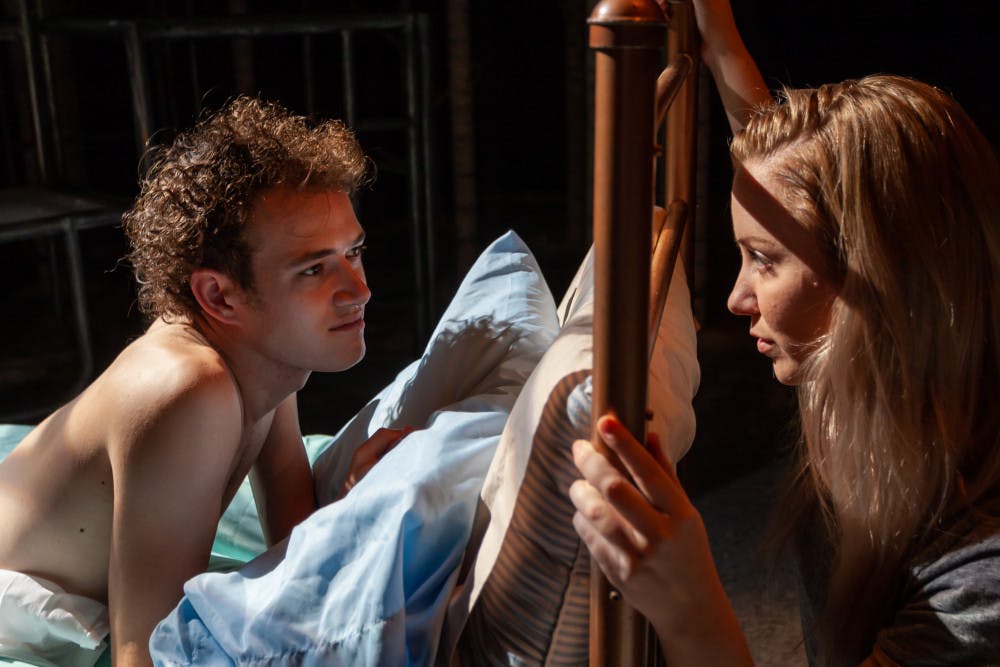Here in Gainesville, Florida, it can be hard to get into the holiday season when midday temperatures are still climbing into the 90s. Even still, the delightfully creepy sense of Halloween has descended upon our city, particularly at the Hippodrome Theatre in downtown Gainesville.
Under the creative direction of Lauren Warhol Caldwell, the Hippodrome is preparing to unveil its bloodiest project of the season. “Let the Right One In” is a theatrical adaptation of John Ajvide Lindqvist’s novel. The narrative has also been adapted on screen.
“Let the Right One In” follows the converging narratives of Oskar, played by Ben Tracy, and Eli, played by Marissa Toogood.
Oskar is a loner who lives on the edge of town with an alcoholic mother who is dependent on her son for comfort and stability. From school, to the gym, to the playground, Oskar is haunted by two ghoulish bullies. Johnny, the more sadistic of the two, urinates on Oskar, forces him to eat dirt, and at one point, nearly allows him to drown.
“I think first and foremost this is a coming-of-age story,” Tracy said. “I mean, there’s obviously horror elements. But at the center of it is this very sweet coming-of-age story.”
In the midst of Oskar’s torment, things start to shift as a rash of murders begin and a young girl named Eli and her father move in next door. Something about Eli seems off to Oskar. She smells, speaks as if she were from a different time period and never gets cold, even when barefoot in the snowy woods. Eli’s “father” is more than he seems, and so is she.
“I love Eli,” Toogood said. “What she is, or what she symbolizes to me. I think she is extremely relatable because we all know that feeling of being caught in between, whether you’re evolving from child to adult or trying to find out where those lines live. She’s been alive for so long and she’s seen so many things, and I really am grateful to be able to tell her story. She’s on this eternal story and to be able to see a snippet of that is fascinating.”
As the murder investigation continues, Oskar and Eli form a bond, granting one another with a feeling completely foreign to their current lives: safety. However, this safety is tenuous, and as Oskar learns more about Eli and her secret, the two are forced to make the decision of who to trust and who to let in.
The story is complex. On the surface, audience members are presented with what seems like a number of classic tropes: bullied kid lives on the edge of town, misunderstood monster and a murderer stalking the woods.
But that’s just the surface. “Let the Right One In” explores the semantics of morality and evil. Throughout the play, viewers are likely to find conflict within themselves, asking questions such as, “even if there were real monsters in our world, would they be more monstrous than humanity?” and “What would you give up to belong?”
“It’s really left up to the audience as to how they perceive it,” Caldwell said. Somebody might not think at all and just think it’s a happy ending. Others may say that the outsiders who have found each other have finally succeeded in overcoming all of these horrible obstacles that are surrounding them. They succeeded in getting away, they let the right one in.”
“You go to some film and they tell you when to cry, they tell you when to laugh, and everybody laughs together and everybody cries together, and it’s on cue,” Caldwell said. “There are some stories that are not like that, so to me, it’s left up to the audience to feel whatever they feel.”
The formatting of the production itself is particularly cinematic, Caldwell said of the transitional nature of each scene. Every word, movement and glance builds an ambiguous yet direct tension that guides the audience without simply pointing to its end game.
Throughout the production, characters engage in physical demonstrations of emotion, tension and conflict. These movements were not a significant part of the original script, but Caldwell saw these movements as an effective way to move the action.
“If you were to just watch the movement, without the dialogue,” Caldwell said, “you would know what the play was about. To me, it’s beautiful to watch an actor’s spine in space.”






